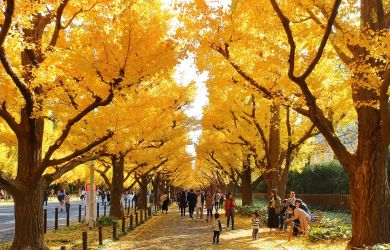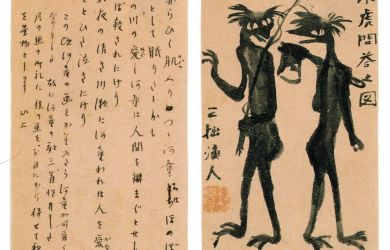
April 3, 2014
The Best of Kyoto Awaits
Exploring Japan’s ancient city just got a whole lot easier
By Metropolis
Originally published on metropolis.co.jp on April 2014
NIJO CASTLE
Nijo Castle is one of 17 UNESCO World Heritage Sites in Kyoto. Originally built over 400 years ago, it was home to the Tokugawa shogunate when the shoguns left their main home in Edo to visit the Imperial Court in Kyoto. Many of the rooms in the Ninomaru Palace, the main building complex of the castle, are designated as National Treasures of Japan.
If you have been to Nijo Castle before, you may notice some differences on your next visit as the castle is currently undergoing a 20-year, ¥10 billion restoration project. So far, the main gate to Ninomaru Palace has been restored with vibrant colors and gold adornments and nearly all of the interior sliding doors have been removed and replaced with perfect replicas created by the leading authorities on the Kano school of painting. Kyoto City is currently receiving donations from those visitors interested in helping make sure the ongoing restoration project is a success.
UPGRADES IN KYOTO FOR TOURISTS

As one of Japan’s most popular destinations, Kyoto has been making a lot of efforts to ensure foreign tourists have a safe and enjoyable visit. The first of these is KYOTO_WiFi, a free new wireless network available at Kyoto City Bus stops, Kyoto Municipal Subway stations and 7-Eleven convenience stores. To gain access to the network, simply send a blank email to kyoto@forguest.wi2.ne.jp, and you will automatically receive an access code. Select the SSID “KYOTO_WiFi01” on your smartphone, tablet or computer and open a web browser to display the login page. Enter the access code and you can enjoy three hours of free internet access. Once the three hours has expired, you can send another email to repeat the process.
Once you have taken advantage of the free Wi-Fi, you can make navigating the city easier by downloading Arukumachi Kyoto, a free app available for iOS and Android. Kyoto offers a variety of great passes for unlimited rides on the bus or train systems, but sometimes having such a pass doesn’t necessarily mean you will have an easy time finding your way. The Arukumachi app changes this by helping you navigate the city while also providing more detailed bus information than would appear in a typical navigation app (all buses carry GPS devices, so you can even see what bus is coming to your stop next). It allows you to see every bus stop on your current route, which is great if you want to look for other points of interest along the way. There is even an option for information and facilities in the area, which displays nearby shops, cafés, points of interest and sightseeing information. Those without a smartphone can access the web-based version at www.arukumachikyoto.jp.
Finally, if you find yourself in a situation requiring emergency services, Kyoto offers multi-lingual phone support in English, Chinese, Korean, Spanish and Portuguese. After dialing the emergency number, 119, you can tell your operator your desired language and they will connect the call to a third-party interpretation service. Foreign visitors can also dial 075-661-3755 between 8am and 9pm daily for event, facility and non-emergency information.

MANGA MUSEUM

The Kyoto International Manga Museum is highly recommended for both die-hard manga fans and those who have never read a Japanese comic. For lovers of manga, the museum is part-library with 50,000 titles to read, including 5,500 foreign language manga and a kids room with over 3,000 children’s books. For the uninitiated, the museum can teach you everything about manga from its history in Japan, to its influence around the world and even the modern manga industry.
The museum is a joint venture between Kyoto City and Kyoto Seika University’s Faculty of Manga. On the weekend, students from the university are available to draw manga portraits of visitors (for a fee) and conduct workshops. For students of the art, there is even a research library that houses various books about manga and historical archives of magazines and periodicals.
The museum has several gallery spaces that are featuring three exhibits this spring. The first, “From Hand to Hand,” showcases art from Japanese and international artists created in response to the 2011 Tohoku earthquake and tsunami. The second, “The Nouvelle Bande Dessinée Exhibition,” is about French comics and their increasing popularity in Japan.
Another great aspect of the museum is the building itself, which previously served as an elementary school dating back to 1869. The museum maintained many architectural elements of the school, and there are explanations of its history throughout. It’s a great setting to learn about one of Japan’s most famous exports or to simply find a cozy spot to read your favorite manga.
KYOTO MUSEUM OF TRADITIONAL CRAFTS

The Kyoto Museum of Traditional Crafts is your gateway to understanding many of the cultural artifacts that make Kyoto famous. The Japanese government maintains a special list of 218 traditional crafts, and since much of Japanese culture originated in Kyoto some 1,200 years ago, it should come as no surprise that it is the leading prefecture with 17 original crafts. The museum showcases a total of 74 Kyoto-specific crafts. Many of these crafts are endangered with few remaining masters, who in some cases have never taken on disciples.
In addition to the crafts themselves, visitors can see regular demonstrations by master craftsmen. Every Sunday, there are workshops to experience fabric dyeing as well as demonstrations of maiko dances, followed by explanations of their traditional adornments.
Admission to the museum is free.

ANIME WRAPPING TRAIN
Until the end of May, select train cars on the Kyoto Municipal Subway will feature vinyl wrappings of images from some popular anime series. The special train decorations were created to promote the Kyoto International Manga Anime Fair, to be held in September. Finding one of these trains will be a bit of a treasure hunt, as only two cars are decorated on a limited number of Karasuma line trains. The schedule for the festooned trains changes daily, so your best bet is to check the info online (http://meturl.com/kyotocitytrains). If navigating that Japanese-only website is not an option, the helpful staff at the Kyoto Tourist Information Center Kyo Navi at Kyoto station should be able to find you the daily schedule.
OTHER SPRING EVENTS
Okazaki Sakura Lightup & Jukkoku-bune Boat Ride
Take in the sakura blossoms in the Okazaki area of Kyoto during their special evening light-up from Thursday, March 27 to Sunday, April 13. For a truly special view of the sakura, consider riding a traditional jukkoku bune, or narrow boat. The popular cruises are being conducted from Thursday, March 27 to Tuesday, May 6 and from Friday, March 28 to Sunday, April 13 in the evening.
Zoo Evening Hours
Kyoto City Zoo is the second oldest in Japan and home to about 130 species of animals from around the world. This spring, the zoo is offering special evening admission and sakura (cherry blossom) viewing on the weekends of April 5-6 and April 12-13. Zoo admission is typically until 5pm but will be extended on these days until 8pm with last entrance at 7:30 so visitors can enjoy special evening illuminations along the pathway.







